Physical Address
304 North Cardinal St.
Dorchester Center, MA 02124
Physical Address
304 North Cardinal St.
Dorchester Center, MA 02124
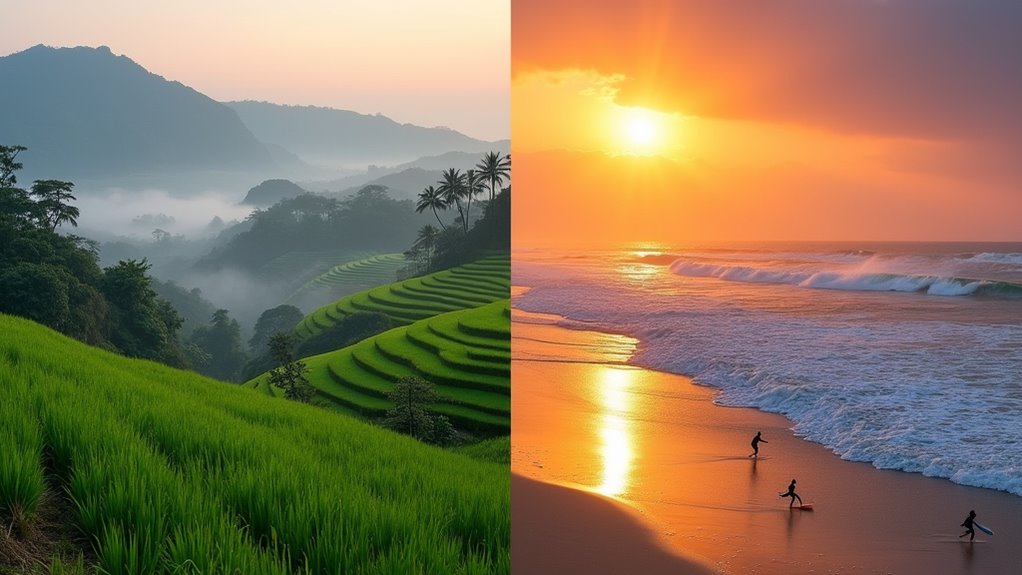
Looking for your perfect Bali match? Ubud's mystical jungles and Canggu's surf culture offer drastically different paradises.
While Ubud whispers with ancient temples and emerald rice terraces, Canggu roars with crashing waves and buzzing beach bars. You’re facing one of Bali’s most common travel dilemmas, and your choice will dramatically shape your island experience. Each destination offers a distinct flavor of paradise—one steeped in cultural tradition, the other riding the edge of tropical modernism. The answer isn’t universal, but depends entirely on what you’re seeking from your Balinese adventure.
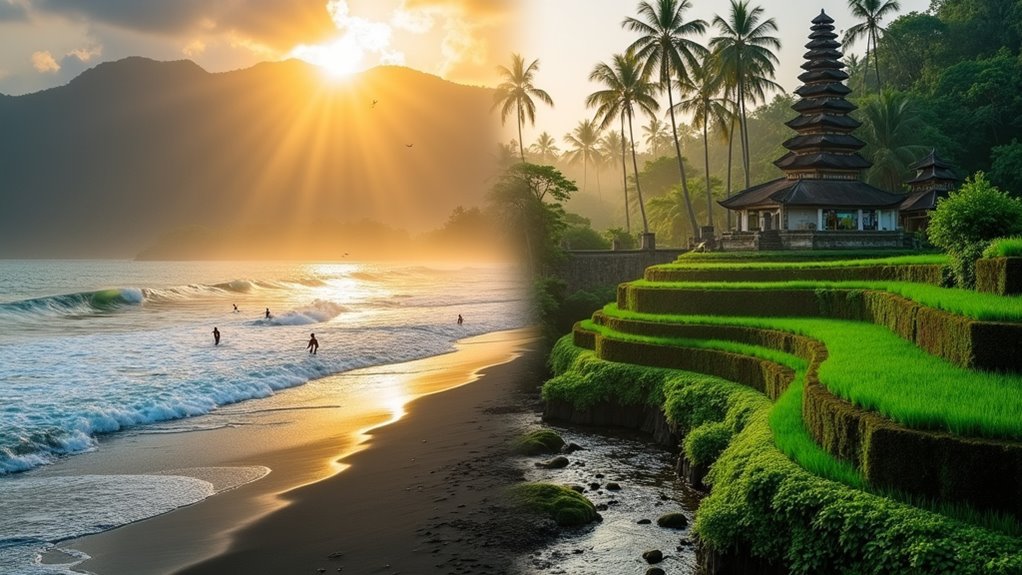
When choosing between Ubud and Canggu, you’re fundamentally deciding between two distinct Balinese environments.
Canggu offers a coastal experience with stunning beaches like Echo, Berawa, and Batu Bolong, perfect for surfing and sunset gatherings. You’ll find beachfront bars and a lively atmosphere along its shores. Canggu is rapidly developing and expected to become Bali’s hottest spot by 2025, surpassing traditional favorites like Kuta and Seminyak. While most of Canggu’s beaches have golden sand, nearby you can discover some of Bali’s unique black sand beaches formed by volcanic activity.
Ubud, meanwhile, delivers an inland retreat surrounded by lush rainforests, rice paddies, and serene waterfalls. You’ll enjoy cooler temperatures than coastal areas and access to scenic walks like the Camphuan Ridge.
While Ubud lacks direct beach access, it compensates with tranquil river views and jungle scenery.
Your choice ultimately depends on whether you prefer ocean vistas and beach culture or immersion in Bali’s verdant inland landscapes and traditional culture.
Choosing the right accommodation in Bali substantially impacts your overall experience, with Ubud and Canggu offering distinctly different options to match varied travel preferences.
Ubud excels with jungle-nestled luxury villas like Four Seasons Resort, yoga retreats at Puri Ahimsa, and traditional homestays that immerse you in Balinese culture.
Experience Ubud’s serene luxury with Four Seasons jungle villas, spiritual yoga retreats, and authentic Balinese homestays.
For something unique, try the Bubble Hotel or eco-friendly Le Sabot Ubud.
Canggu delivers beachfront living with surfing-focused accommodations and digital nomad-friendly coliving spaces.
It’s particularly strong in both high-end villas with private pools and budget-friendly hostels.
Couples often prefer Ubud’s romantic settings, while solo travelers appreciate Canggu’s social atmosphere. With Bali welcoming over 6.3 million travelers in 2024, both areas have expanded their accommodation offerings to meet diverse visitor needs.
Families find suitable options in both areas, with Adiwana Monkey Forest in Ubud and beachside resorts in Canggu.
If you’re extending your stay to explore other regions, Uluwatu offers breakfast spots that provide stunning ocean views while dining.
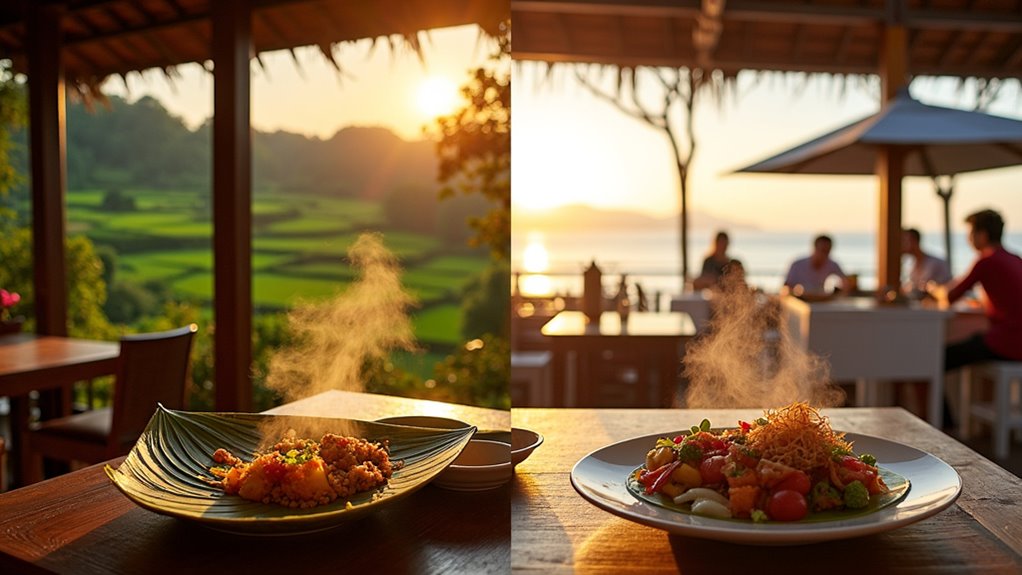
Beyond where you rest your head at night, Bali’s culinary landscape will shape your travel memories just as powerfully. Both destinations offer distinctive food experiences that cater to every palate and budget.
Ubud excels in traditional Balinese cuisine, with Ibu Oka’s famous Babi Guling highlighting centuries-old cooking techniques.
Meanwhile, Canggu embraces modern international influences at spots like Skool Kitchen and Mosto.
Your dining priorities might include:
The dining atmosphere reflects each area’s character—lush jungle settings in Ubud versus beachfront casual-chic in Canggu.
For fine dining enthusiasts, Ubud offers restaurants like Hujan Locale serving exceptional farm-to-table Indonesian fusion dishes that cater to various dietary needs.
For a more laid-back dining experience between these two popular areas, consider visiting Sanur Beach where you’ll find a perfect blend of local and international cuisine options.
Bali has rapidly evolved into a premier destination for remote workers, with both Ubud and Canggu developing distinct digital nomad ecosystems.
In Ubud, you’ll find renowned coworking spaces like Outpost and Hubud offering jungle views, poolside workstations, and on-site yoga. The Digital Nomad Visa has further solidified Bali’s status as a long-term option for remote professionals. The serene environment promotes focused productivity amid rice fields and cultural attractions at a more affordable cost.
Canggu delivers a contrasting experience with coworking spaces integrated into its vibrant social scene. You’re never far from beach clubs and nightlife after closing your laptop. For those seeking a break from work, Jakarta offers thrilling adventures just a short flight away from either location.
Internet speeds are reliable in both locations, but you’ll pay a premium for Canggu’s beachside lifestyle.
Your choice comes down to preferences: Ubud’s tranquil, wellness-oriented community or Canggu’s dynamic social atmosphere where work meets play at sunset.
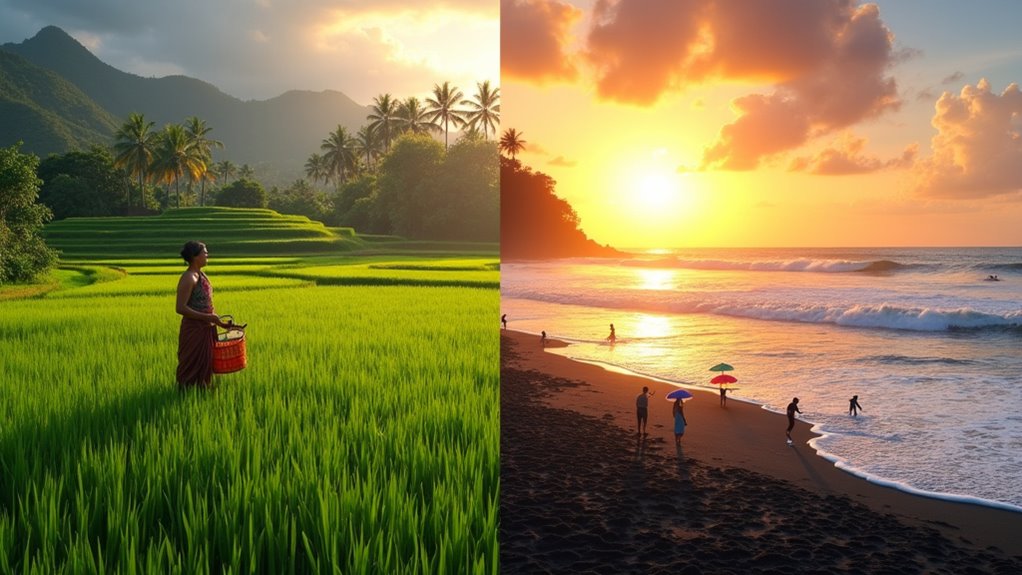
When it comes to culture, Ubud and Canggu offer distinctly different experiences that reflect Bali’s prosperous legacy in contrasting ways. Ubud serves as Bali’s cultural heart with traditional performances at Ubud Palace, sacred temples, and ancient rituals at Tirta Empul. While Ubud boasts rich cultural attractions including the sacred monkey forest sanctuary, visitors can witness Balinese traditions up close in this unique natural setting. Many travelers consider Ubud a must-visit destination for its authentic representation of traditional Balinese arts and spirituality.
Visit Ubud for deep cultural traditions or choose Canggu for a modern interpretation of Balinese heritage—each offering unique windows into this island’s rich spiritual tapestry.
While Ubud cherishes cultural heritage, recreation and adventure create equally compelling reasons to visit either destination.
Canggu dominates water activities with consistent waves at Echo, Berawa, and Batu Bolong beaches. You’ll find surfboard rentals and lessons readily available for all skill levels. For thrill-seekers looking beyond surfing, Bali offers various exciting adventure activities throughout the island.
Ubud compensates with jungle-based adventures including Mount Batur hikes, Campuhan Ridge treks, and the Monkey Forest Sanctuary. Walking in Ubud requires navigating broken sidewalks and hazardous conditions that frequently cause tourist injuries.
White-water rafting and waterfall exploration replace coastal activities here.
For wellness seekers, Ubud offers premium yoga studios and traditional healing practices enhanced by jungle surroundings.
Canggu provides beachfront yoga with sunset views, primarily catering to surfers and digital nomads.
Both locations serve as convenient hubs for day trips – Canggu offers easy access to Tanah Lot and neighboring islands, while Ubud’s central location puts temples and volcanoes within reach.
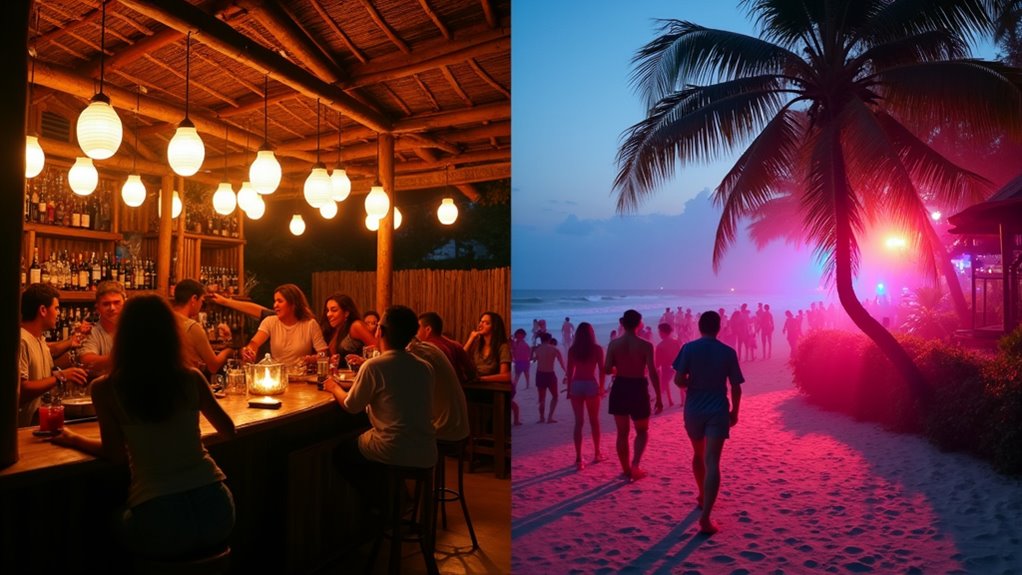
The nightlife experiences in Ubud and Canggu couldn’t be more different, reflecting each area’s distinct character and visitor demographics. Canggu pulses with beachfront bars, DJ events, and late-night parties that attract a younger crowd of surfers and digital nomads. Minimum spends and higher prices come with the territory. Popular spots like La Brisa and Finn’s Beach Club offer stunning sunset views with crafted cocktails.
Meanwhile, Ubud embraces a more subdued evening atmosphere with:
Ubud offers gentle nightfall rhythms that mirror its spiritual essence—perfect for those seeking depth over decibels.
Your preference depends entirely on whether you’re seeking Instagram-worthy beach club experiences or contemplative evenings after a day of culture. Many visitors are drawn to experience both areas during their trip to fully appreciate the Island of Gods and its diverse cultural offerings.
Understanding your potential expenses in Ubud versus Canggu will help you make a more informed decision about which destination suits your financial situation.
Accommodation costs vary considerably, with Ubud offering guesthouses from $300/month while Canggu starts around $400/month for co-living spaces.
Canggu’s premium extends to food, where health-focused cafés typically cost more than Ubud’s dining options. Both locations allow you to enjoy meals at local warungs where you can eat for just a few dollars.
Each location has its specialty expenses: Ubud’s cultural workshops ($20-50) and dance performances ($10-20) versus Canggu’s surf rentals ($10/day) and premium coworking spaces like Dojo ($200/month).
If traveling with children, many visitors opt for family-friendly resorts in Seminyak as a middle-ground option between the two areas.
For long-term stays, factor in visa runs ($50-100 bimonthly), scooter rental ($60-100/month), and health insurance ($50-150/month).
Canggu generally demands a higher overall budget due to its influencer-driven economy.
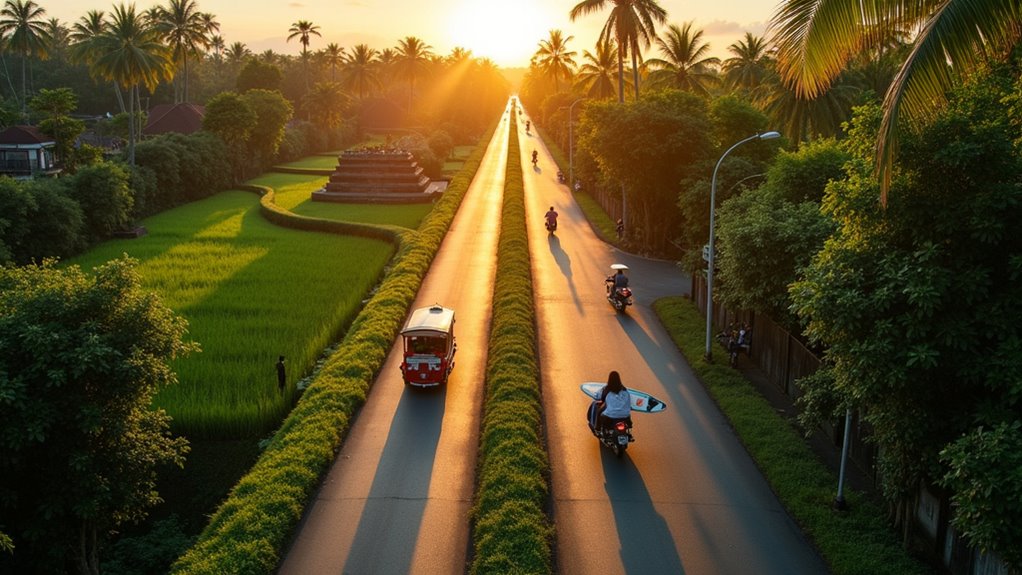
Getting around Bali considerably impacts both your budget and experience, making transportation choices a key factor when deciding between Ubud and Canggu. Traffic congestion and narrow roads characterize both areas, especially during peak hours.
Transportation choices can make or break your Bali experience—plan wisely to navigate the congested roads of Ubud and Canggu.
Your transportation options include:
Ride-sharing apps work well for shorter trips, while scooters let you navigate traffic efficiently and explore scenic routes. The drive time between Ubud and Canggu is just over an hour under ideal conditions, though traffic can significantly increase travel time. For travelers seeking a more luxurious experience, Nusa Dua’s resorts offer exclusive transportation services that eliminate navigation hassles entirely.
Consider your comfort level with local driving conditions when choosing your transportation method.
Choosing between Ubud and Canggu largely depends on your personal travel style and priorities, as each destination attracts distinctly different visitor profiles.
You’ll thrive in Ubud if you’re a cultural enthusiast seeking spiritual experiences, traditional art, or wellness retreats. It’s perfect for slow travelers who prefer immersive experiences in Hindu-Balinese culture, rice terrace explorations, or forest therapy. Ubud’s popularity is reflected in Gianyar region capturing 13.3% of travelers visiting Bali in 2024, establishing it as a cultural and spiritual hub.
Canggu suits digital nomads needing co-working spaces and networking opportunities. It’s also ideal for intermediate surfers, nightlife lovers, and fitness enthusiasts. The Bali destination offers a more contemporary coastal experience compared to Ubud’s traditional setting. Young social travelers appreciate Canggu’s vibrant scene, from budget hostels to beach clubs with sunset views.
Consider your priorities: culture and spiritual renewal in Ubud versus beach access, surfing, and social opportunities in Canggu.
You’ve seen what Bali offers through two distinct lenses. Ubud’s cultural heart beats among emerald rice terraces while Canggu’s surf breaks crash against trendy shores. Don’t overthink it—choose Ubud for spiritual growth and artistic immersion, or Canggu for social butterflies and digital nomads who crave salt air. Your perfect Bali isn’t about which is better, but which reflects your travel soul. The island awaits—pick your paradise.